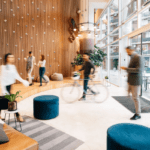
4 Signs You Need to Invest in Your Workplace Experience
Whether you’re on the workplace services team or in facilities, you’re well aware by this point that the modern worker expects way more out of their workplace than ever before. According to one Sodexo report, 67% of knowledge workers left their previous employer partly because their workplace was not optimized for them. And at the same time, with so much intuitive tech available to make life outside of work easier, the bar is rising for how workplace tech can bridge the gap.
But what exactly does it look and feel like when you’re not meeting that bar? Here’s your quick reminder to take a closer look around your office. If any of these workplace dynamics seem familiar, it’s probably time to start re-evaluating your approach to your workplace—and consider the tech that can help you get back on track.
1. Your employees are shivering (in the summer) and sweltering (in the winter)—and their complaints are swallowing up the facilities team’s time.
You’ve heard this from us before: it’s frustrating to be an employee with absolutely no control over certain basic comfort factors in the workplace. Whether they’re trapped in a long meeting in an overheated conference room or have resorted to illegal space heaters under their desks, temperature is the number one complaint by employees, and a major time suck for facilities teams.
Fortunately for you (and your employees), the world of digital workplace tech has evolved to help. By bridging the gap between the physical (your building) and the digital (hello, smartphone), workplace apps like Comfy empower employees to take control of issues while saving YOU (and your facilities teams) time. Comfy allows employees to control their thermal comfort whether they’re at their desk, in a meeting room, or in a common area, and provides access to a heat map to help identify an area of the office that’s more comfortable. Meanwhile, facilities teams don’t get inundated with tickets, and save both time and overall HVAC energy spend as a result.
2. Employees complain that there aren’t enough meeting rooms, but when you walk around, the rooms are empty.
Let’s be real: your employees are used to apps that can instantly connect them to whatever they need within seconds—be it a ride home on Uber or an available reservation on OpenTable—which makes it incredibly frustrating to come to work and and not even be able to find an open meeting room. A Steelcase survey reported that 40% of workers waste up to 30 minutes per day searching for space to collaborate. One reason is that they can be hard to find. And if your employees are spending more time running around the office looking for an open room (“where is conference room 2-5F again?”), it just means that they’re not being productive with the work they should be doing. Meanwhile, your physical room audits and calendar booking systems are telling you that not all rooms are being booked nor used, which makes it very hard for you to gain a clear picture of how efficiently space is used on any given floor, within any building, and across your campus.
Higher room utilization shouldn’t be so hard to achieve. And neither should giving your employees the same on-demand, contextualized experience (like with, say, Google Maps) in their workplace as they get outside of work. Unfortunately, the tools that people use to reserve space at work are not exactly intuitive. Comfy believes that having context in an easy-to-use layout is important for people to be able to truly connect with the people, places, and services they need to be productive at work. Instead of looking at a list of room names in the calendar, or running around for 15 minutes, an employee can look at a simple map view, see all the available spaces that are near them, and book what they need, all within three clicks. Boom!
3. Whether it’s the late-night eye strain when the office lights shut off, or furrowed-brow squints from those super bright meeting rooms, it’s no wonder the office is running out of headache medicine.
Many buildings now have LED lighting with occupancy sensors, but some of the smart features still aren’t reaching the employee. For example, employees aren’t taking advantage of dimmable, localized lighting control because the light switch sits at an opposite wall as part of nameless bank of switches. That’s unfortunate because many of today’s employees struggle with both over-illumination of their workspace as well as poorly lit workspace, and it feels like there’s no middle ground. A new study found that spending too much time in dim areas like poorly lit offices impacted mental acuity. And for employees working late at night or early in the morning, there’s simply no intuitive way to adjust the lighting. For this reason, workplace teams end up leaving lights on 24/7, resulting in significant energy waste; lighting is still the second largest end use of electricity (17%) in commercial buildings.
Before you ask employees to start waving their arms around hoping for the lights to come back on, know that there’s a better, smarter experience available. Through workplace apps like Comfy, employees can quickly and efficiently adjust light levels on their own from one single app, without your team having to update the lighting system. Minimize your headaches and theirs.
4. You don’t hear about any office issues (lost whiteboard markers, broken projectors, video conferencing system and wifi issues) until they become a firedrill right before a super important meeting.
It’s hard to fix anything if you don’t know it’s broken. But facilities and IT teams often lack visibility into issues, because employees don’t care (or have time or the channel) to report them through standard ticketing systems. Workplace teams then have to resort to (time-consuming) physical walks around the office to see what’s broken or needs fixing, or wait until things get escalated in urgent fashion: “The board members are here, BUT THE TV IS ON THE FRITZ AND WE DON’T HAVE WHITEBOARD MARKERS AS BACKUP!” Neither dynamic is efficient, productive (or particularly pleasant) for anyone involved.
So forget about asking employees to log into some archaic system to inform you about office issues—they’re not gonna do it. Instead, make it as easy as ordering lunch from their desk: with a few clicks through a workplace app on their smartphone (ahem… Comfy), employees can submit work requests quickly, making them feel heard—while workplace teams can prioritize and manage the feedback more efficiently, and get issues get resolved faster (and with a whole lot less drama).
“Workplace apps give employees more choice and control in where, when, and how they work—saving you time, and giving your employees more reason to stick around for years to come.”
Ultimately, you may have a lot of these bases somewhat covered when it comes to workplace management: a room reservation system, connected lighting systems, space planning software, random seating plans floating around in spreadsheets, and the standard ticketing/work order systems to help field building issues. But managing these disparate systems and the valuable data that they produce can be time-consuming. Now, what if you could only get the information you need from an aggregated source, while providing a simple and intuitive experience to your employees? Comfy’s workplace experience app connects to the systems you’ve already put in place, so that you can simultaneously get the information you need while providing a consumer-like app experience that delights and empowers employees.
By offering better real-time connections to the physical and digital workplace, workplace apps give employees more choice and control in where, when, and how they work—saving you time, and giving your employees more reason to stick around for years to come.
Learn more about Comfy’s latest workplace app features.
The brightest way to operate, orchestrate, and optimize everyday spaces.


